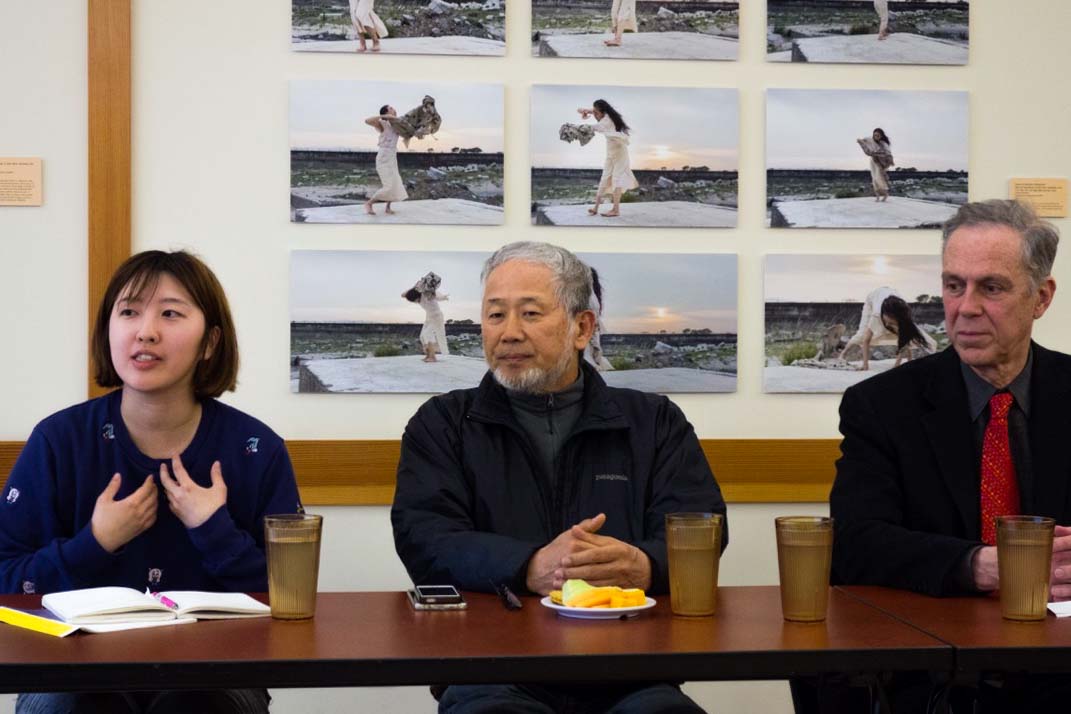
Ben Medina, Staff Writer
Last Thursday, a talk at the Mansfield Freeman Center for East Asian Studies featured a panel filled by translator Haenah Kwon ’17, artist Jisong Lee, curator Patrick Dowdey, “Light of the East: The Beauty of Movement in Silence” co-curator Phoebe Shin, and Film Studies Professor Lisa Dombrowski. “Light of the East” is an exhibition currently on view in the Center and is the first exhibition that Lee and his collaborator, Youngho Kim, have presented outside Korea. (Kim was unable to attend the talk.)
Queries from both the panel and the audience were directed to Mr. Lee via Kwon regarding his art, context, and working methods. In the previous Argus coverage of the exhibit, I referred to his work as “yoga art,” in that it belongs to a category of film and video art, both narrative and non-narrative, that works to create a sense of inner calm or focus by directing its audiences’ attention to a typically statically framed filmed image or set of filmed images that slowly and subtly shift and change through time.
In the broader conversation about art and cinema, this type of work is referred to as “slow cinema.” Typical components include lengthy static shots, often focusing on nature or people. Very few close-ups are employed, as the emphasis is less on the individual, emotion, or narrative in the traditional sense, and more on revealing relationships between people, objects, technology, and nature, all through quiet and rigorously focused observation.
I am of course speaking incredibly broadly here, but I still think it’s useful to contextualize Lee’s work. Strains of this slow cinema or yoga art can be found in Andy Warhol’s eight-hour observation of the Empire State Building, Chantal Akerman’s monumental and ravishing observational cinema, Tsai Ming-liang’s consistently awe-inspiring output, or Harvard’s Sensory Ethnography Lab’s “Manakamana,” a set of six long takes of people (and at one point goats) riding a cable car up and down a Nepalese mountain.
If you’re collecting the action figures of slow cinema, these are the plasticine figures with which Lee is taking up shelf space. His work creates transcendence through its stillness. The gluing through-line is not a narrative or character or set of experiences, but instead our faith in his eye selecting the frames we contemplate, and in the intelligence he demonstrates in choosing these slices of reality in this order for the duration.
Throughout the hour-long panel, Lee was effusive, focused, calm, and very funny. He spoke of his interest in Buddhism and meditation, and his exploration of a certain kind of productive boredom. Process, time, space, nature, attention, reflection. Within the context of Wesleyan, his sustained and focused films create a briefly calming pocket outside the endlessly hyperlinked all-tabs-all-open socio-technological whirligig of consciousness that I typically dedicate my days and nights to riding until I disintegrate.
My own congested and hyperbolic writing aside, Lee spoke at length about his use of simplicity and a careful and sustained expenditure of time and resources to shape his work. He ardently avoids a planning process, relying instead on the places he travels for new sensations and ideas.
His exhibited work is a series of quiet meditations on a single shot. He sets up a frame, using his phone and one of two spindly portable tripods, and lets it sit until he decides enough has been filmed. He takes this practice around the world, filming Huayna Picchu (baby Machu Picchu) in “Space Theater.” In “1/75,” we’re looking out the back window of a train.
Lee says that he avoids speaking when he travels, and he likens this habit to the silence training of Buddhist monks. Silence leads to discomfort, and often to feeling stupid, but he reported that after a day or so he comes to enjoy the stupidity and silence. If you can speak and have a question, it can easily be resolved through language. However, if one is silent and cannot speak, then an answer to your question must be imagined through the meticulous accumulation of minor details into an edifice of imagined understanding.
This quiet contemplation is the work leading to the decision of what to film, from what angle, and for how long. Lee’s intention is to do “easy work,” work that is easy to film and easy to edit. This is a liberation from his goal-conscious and restrictive background in advertising and creating commercials. In advertising, each work tries for, and fails to achieve, perfection. In his present work, however, each piece completely inhabits itself, with its own actualized meaning.
Comments are closed